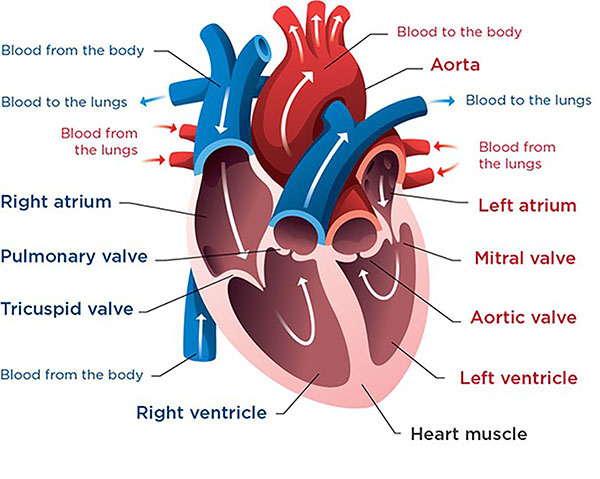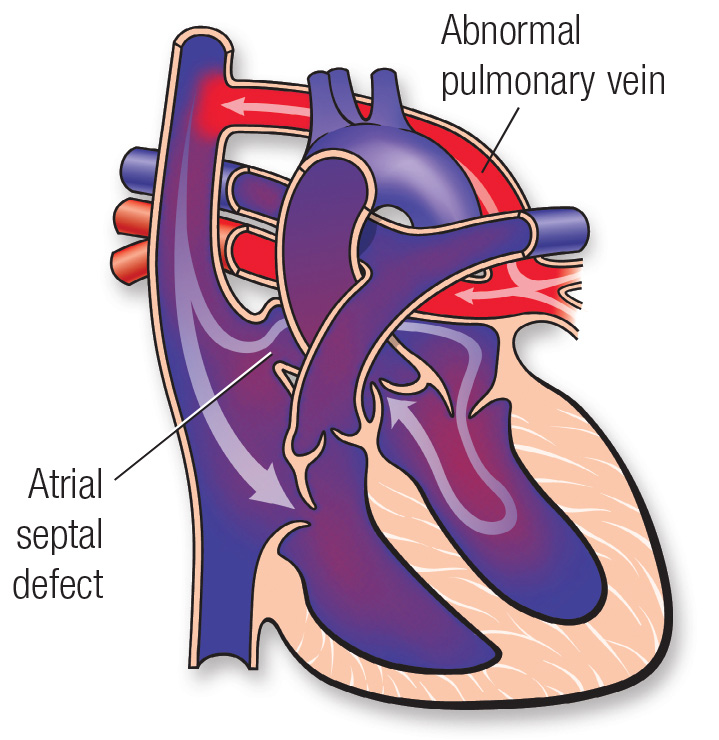Total Anomalous Pulmonary Venous Return
What is total anomalous pulmonary venous return?
Total anomalous pulmonary venous return (TAPVR) is a birth defect in which the veins from the lungs do not connect to the left atrium. Instead, they connect to the right atrium or to the blood vessels leading into the right atrium.
With this condition, the baby’s body does not get as much oxygen as it should. Their right ventricle and pulmonary artery (which carries blood from the right ventricle to the lungs) will both become larger than normal because they are handling too much blood.
 This is a healthy heart. Veins bringing red (oxygen-rich) blood from the lungs connect to the left atrium. In babies with TAPVR, these veins connect to the right atrium or to the blood vessels leading into the right atrium.
This is a healthy heart. Veins bringing red (oxygen-rich) blood from the lungs connect to the left atrium. In babies with TAPVR, these veins connect to the right atrium or to the blood vessels leading into the right atrium.-
How does blood normally flow?
Normally, 4 veins come from the lungs (2 from the left lung and 2 from the right lung). They carry red (oxygen-rich) blood into the left atrium. Then the blood flows into the left ventricle, which pumps blood out to the body.
After taking oxygen around the body, the blood returns to the heart and goes into the right atrium. Then it flows into the right ventricle, which pumps it to the lungs to pick up oxygen.
-
How does blood flow in TAPVR?
 From heart.org. ©2009, American Heart Association, Inc.
From heart.org. ©2009, American Heart Association, Inc.Usually in TAPVR, the 4 veins from the lungs join to form 1 common vein. This connects to the right atrium or to the vessels that bring blue (oxygen-poor) blood from the body into the right atrium.
Sometimes, the 4 lung veins do not join but take different routes. This is called mixed TAPVR. In either case, most blood flows only between the right side of the heart and the lungs, not out to the rest of the body.
Babies with TAPVR get some blood to their body because they have a hole in the wall between their atria (atrial septal defect, ASD). Some mixed blood (oxygen-poor and oxygen-rich) flows from the right atrium through the hole into the left atrium. Then it flows into the left ventricle, which pumps it out to the body.
In some babies, the lung veins are blocked, which causes more severe problems with blood flow and breathing.
Symptoms of Total Anomalous Pulmonary Venous Return
Most babies with this condition start to have symptoms soon after birth. They may have symptoms like these:
- Fast breathing or working hard to breathe
- Being more tired than normal
- Trouble feeding
- Not growing as fast as normal
- Skin may look blue or purple tinged, mottled (different shades or colors), grayish or paler than usual; the lips, mouth, gums, fingernails or toenails may look bluish (cyanosis)
Some children do not start having symptoms until later in infancy.
Heart Center at Seattle Children's
Diagnosing Total Anomalous Pulmonary Venous Return
-
Fetal diagnosis of total anomalous pulmonary venous return
Often, doctors can diagnose TAPVR when a baby is in the womb using a fetal echocardiogram (fetal echo). This is a special ultrasound that uses sound waves to view and make pictures of a developing baby’s heart during pregnancy. The results are interpreted by a pediatric heart doctor (cardiologist) who specializes in fetal congenital heart disease.
Your obstetrician may refer you for a fetal echo if your family has a history of congenital heart disease or if a routine prenatal ultrasound shows a problem.
Seattle Children’s Fetal Care and Treatment Center team can care for you when you are pregnant if your developing baby has a known or suspected problem.
-
Diagnosing total anomalous pulmonary venous return after birth
To diagnose this condition, your child’s doctor will examine your child and use a stethoscope to listen to their heart.
The doctor will ask for details about your child’s symptoms, their health history and your family health history.
Your child will also need tests that provide information about how their heart looks and works. These may include:
Treating Total Anomalous Pulmonary Venous Return
This condition can only be repaired by surgery.
In the operation, the surgeon opens the back of the left atrium and connects the common vein to the left atrium. This creates proper flow of oxygen-rich blood from the lungs to the heart. The surgeon also closes the abnormal connection that went to the right side of the heart, as well as the atrial septal defect.
The timing of the surgery depends on how severe your child’s condition is. Some children need surgery soon after birth because they have severe symptoms. Sometimes doctors can stabilize babies who have a blocked common vein by using cardiac catheterization to place a stent in this vein.
If your child’s symptoms are not severe, the doctor may suggest waiting so your child can grow. This makes it easier to do the surgery. Most children have surgery by the age of 6 months.
Total Anomalous Pulmonary Venous Return at Seattle Children’s
-
The experts you need are here
- The Heart Center team includes more than 40 pediatric cardiologists who diagnose and treat every kind of heart problem. We have treated many children with TAPVR.
- Our doctors and surgeons are experts in the treatments your child may need, including surgery to change their blood flow. Our outcomes are among the best in the nation.
- We also have a pediatric cardiac anesthesia team and Cardiac Intensive Care Unit for children who need them. General anesthesia is a medicine we give to people before surgery so they are fully asleep during the procedure.
- Your child’s team includes other experts from Seattle Children’s based on their needs, like neonatologists and pulmonologists.
-
Care from before birth through young adulthood
- If your developing baby is diagnosed with TAPVR before birth, Seattle Children’s Fetal Care and Treatment Center team works closely with you and your family to plan and prepare for any care your baby may need.
- Your child’s treatment plan is custom-made. We plan and carry out their treatment based on the specific details of their heart condition. We closely check your child’s needs to make sure they get the care that is right for them at every age.
- We have a special Adult Congenital Heart Disease Program to meet your child’s long-term healthcare needs. This program, shared with the University of Washington, transitions your child to adult care when they are ready.
-
Support for your whole family
- We are committed to your child’s overall health and well-being and to helping your child live a full and active life.
- Whatever types of care your child needs, we will help your family through this experience. We will discuss your child’s condition and treatment options in ways you understand and involve you in every decision.
- Our Child Life specialists know how to help children understand their illnesses and treatments in ways that make sense for their age.
- Seattle Children’s has many resources, from financial to spiritual, to support your child and your family and make your experience as smooth as possible.
- Many children and families travel to Seattle Children’s for heart surgery or other care. We help you coordinate travel and housing so you can stay focused on your child.
- Read more about the supportive care we offer.
Contact Us
Contact the Heart Center at 206-987-2515 for an appointment, second opinion or more information.
Providers, see how to refer a patient.
Related Links
Paying for Care
Learn about paying for care at Seattle Children’s, including insurance coverage, billing and financial assistance.


